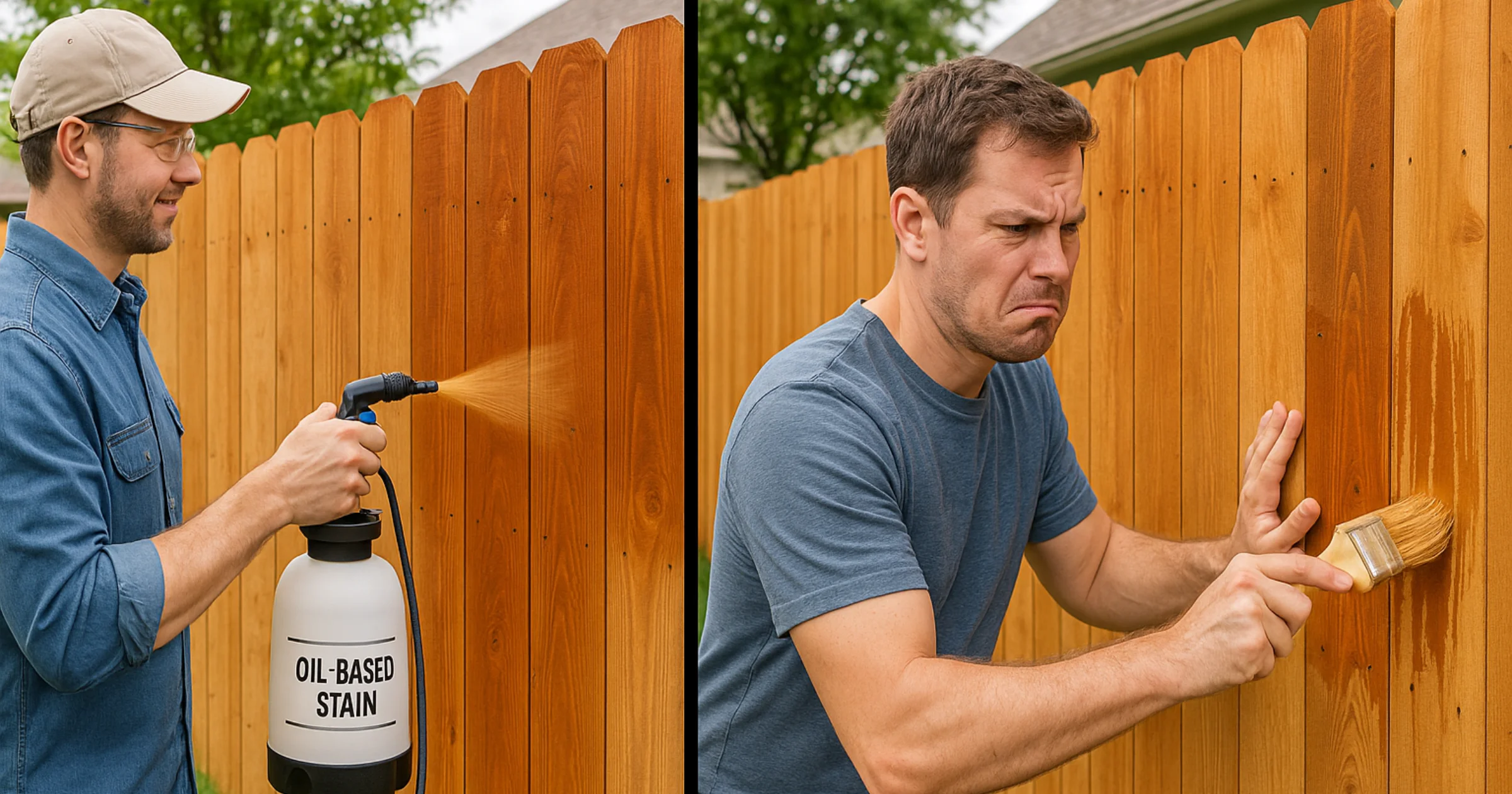
If you’re a homeowner considering a DIY fence staining project, one of the first questions you’ll face is: should I use oil-based vs water-based fence stain? Both are widely available at big-box stores and paint suppliers, but the truth is—when it comes to DIY—oil-based stain is the better option. Here’s why.
Oil-Based vs Water-Based Fence Stain: Key Differences
Understanding the fundamental differences between oil-based vs water-based fence stain helps you make the right choice for your DIY project.
1. Ease of Application
- Water-Based Stain:
Applying water-based stain requires skill. It’s prone to drip marks, especially in sunny, hot weather where drips can dry within minutes. Once they harden, they’re very difficult to remove. For this reason, you usually need two people, one spraying or brushing, and another immediately back-brushing to smooth out drips.
Water-based stain also doesn’t work well with inexpensive sprayers. Homeowners often end up using brushes or rollers, which can take two full days to cover a 200 ft, 6 ft-high fence. - Oil-Based Stain:
Much more forgiving for DIYers. You can use a simple pump-up sprayer (around $20–$30 at Home Depot or Lowe’s) and finish the same 200 ft fence in about 4 hours with proper fence preparation techniques. The stain self-levels, penetrates the wood, and leaves a smooth finish without needing constant back-brushing.
2. Longevity & Durability
Many water-based stains are advertised to last 6–8 years, but in real-world conditions, both oil-based vs water-based fence stain options last about 3–4 years, though proper maintenance extends fence life significantly. There’s no clear advantage here, and multiple coats of water-based stain may be required to achieve the desired look, adding to the workload.
3. Cost Comparison
- Oil-Based Stain: Around $190–$210 for a 5-gallon bucket (~$43–$45 per gallon).
- Water-Based Stain: Often $50–$55 per gallon at retail unless you have a contractor account for professional fence staining rates.
Coverage also tells a different story. While manufacturers claim water-based stains cover 200–400 sq. ft per gallon, in practice it’s closer to 175–200 sq. ft, especially on new wood. Oil-based stains have more consistent coverage, making them the cheaper option overall.
4. Equipment Costs

If you want to apply water-based stain quickly, you’ll need professional equipment. A decent electric sprayer for homeowners costs $200–$300, and contractor-grade sprayers can run up to $1,200. Oil-based stains, on the other hand, work just fine with a $30 pump sprayer, unlike water-based fence cleaning applications that require expensive equipment.
5. Recommended Oil-Based Stains
For DIY homeowners choosing between oil-based vs water-based fence stain, these are the best oil-based options:
- Expert Stain & Seal – Premium, contractor-grade, but available for home delivery. Ships in 2 days and highly reviewed on Facebook groups.
- Ready Seal – Readily available at Home Depot and Lowe’s, easy to apply, and very popular for DIY fence staining projects.
Both are excellent choices, but if you’d rather not deal with any of the hassle, you can always call a professional like Ninja Fence Staining for fast, affordable, and HOA-compliant results.
Frequently Asked Questions About Oil-Based vs Water-Based Fence Stain
Q: Which lasts longer – oil-based vs water-based fence stain?
A: Both typically last 3-4 years in real-world conditions, despite manufacturers’ claims of 6-8 years for water-based products.
Q: Can I use the same equipment for oil-based vs water-based fence stain?
A: Oil-based stains work with inexpensive pump sprayers, while water-based stains require professional equipment for best results.
Q: Which is easier to apply for beginners?
A: Oil-based stain is much more forgiving for DIY applications. It self-levels and doesn’t require immediate back-brushing like water-based stains.
Q: What’s the cost difference between oil-based vs water-based fence stain?
A: While water-based stains cost more per gallon ($50-55), oil-based stains offer better coverage and lower equipment costs, making them more economical overall.
Q: Do I need professional help to choose between oil-based vs water-based fence stain?
A: For most DIY projects, oil-based stain is the clear winner. However, professionals can provide personalized recommendations based on your specific fence and climate conditions.
Oil-Based Wins for DIY
When you compare application, cost, coverage, and equipment needs for oil-based vs water-based fence stain, the answer is clear: oil-based stain is the best choice for DIY fence staining projects. It saves you time, money, and frustration, while delivering a smooth, professional-looking finish.
Need help with your project? Contact expert fence staining contractors in Houston for professional application. We’ve completed hundreds of fences across Houston, and we’ll make sure your project gets done right the first time.
This guide is provided by Ninja Fence Staining for educational purposes. For professional fence staining services in Houston, Cypress, and surrounding areas, contact Ninja Fence Staining at (832) 258-6164. Always follow manufacturer safety guidelines and local regulations when handling staining products.

